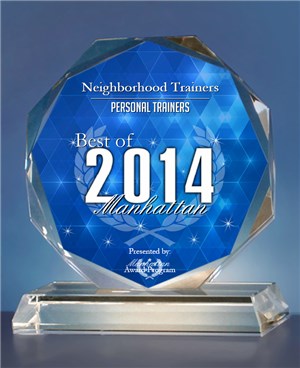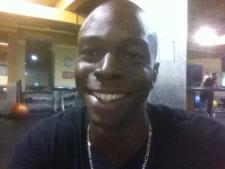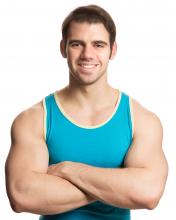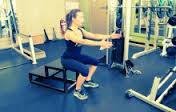 |
| Best of Manhattan 2014 for Personal Trainers |
|
|
Please Welcome to the
Neighborhood
 Stephanie Marks
Jason Senior 
Lloyd Wright
Avery James
Andrew Lerner
Dawn Derow
""We met for an initial consultation and she is going to start training with me on Friday. She will be
the second client who found me on Neighborhood Trainers!"- Noelle
|
 All For Forearms? All For Forearms?
 By Jason Greenberg, personal trainer
By Jason Greenberg, personal trainer
.
I have a few clients and business contacts who have been coming to me recently to express their woes about the size of their forearms. Though the muscles of the forearms are instrumental in grip strength, at a superficial level, it would appear that most workouts gloss over all exercises that target them.
But this is a fallacy. If a program is devoid of isolation exercises for the forearms, that doesn't mean that the forearms aren't getting worked! Check your workouts to make sure you have any of these three key compound exercises, all of which benefit the forearms.
#1. Deadlift
This exercise is a bit more on the complex side, but it's very advantageous (once mastered) for almost the entire body. While the posterior chain-the back, the glutes, and the hamstrings-is the primary beneficiary, it's important to not downplay the crucial role of the forearms in the movement. If you're planning on repeatedly moving a hundred pounds or three off the ground, you're going to need a strong grip!
Unfortunately, there are many lifters who opt for quantity over quality, using lifting straps and other means in order to lift more weight. There's nothing wrong with this-it's important to continue challenging the prime mover muscles-but making such an accommodation comes at the detriment of forearm strength.
#2. Farmer's Walk
During my time at Equinox, I was told once that there are seven basic types of movements: vertical pull, vertical push, horizontal pull, horizontal push, squat, hinge, and locomotion. Though the first six of those movements feature prominently in every workout program, locomotion is usually overlooked. This is a pity, as locomotion-based exercises are key to functional training.
Exercises such as the farmer's walk (and its sibling, the more demanding walking lunge) mirror everyday activities, hence their usefulness. The farmer's walk is essentially the same as a regular stroll-the only difference being that the gymgoer holds weights in both hands. And it's the prolonged carrying of weight that challenges the forearms.
#3. Pull-up
The brachioradialis (literally, "relating to the arm's radius") is one of the major superficial muscles of the forearm, and it's used whenever a person bends his or her elbow, just like the biceps. What this means is that any exercise involving the biceps muscles also strengthens the forearms. I chose the pull-up as the prime example of a compound exercise targeting the biceps and brachioradialis, but any vertical or horizontal pulling movement would suffice.
With pull-ups, the forearms both help to move the body towards the bar and to stabilize the body throughout the movement. And unlike most back training exercises, there is no contact with the ground, which increases the exercise's complexity.
Maximize your workouts and get in touch with Jason!
|

|
 Refer Your Favorite Fitness Pro Refer Your Favorite Fitness Pro
Let new clients find them here. NeighborhoodTrainers is looking for great trainers and instructors in Manhattan, Brooklyn, Queens, Staten Island, & the Bronx.
|
|
Adding 150 minutes of brisk walking to your routine each week can add 3.4 years to your lifespan.
This month Sarah,
Lisa, and Jason
have some motivating information for you.
Finally, this month we are celebrating 5 years of helping people connect with personal trainers. Please, leave us a note on our Facebook page and share it with friends. Thanks!
Healthy regards,
Glenn
P.S. For daily fitness tips and advice,

|
 |
 The Squat The Squat

Th
e squat is a complex lift that if executed correctly can be great for fat loss. If you are unfamiliar with the squat it is important to;
1. Asses your mobility in the hips, ankles and shoulders and
2. Learn to properly fire/ activate your Glute muscles.
Most women are quad dominant (fire quads before glutes and hamstrings) and so it is extra important to address the "glute firing" early on so that emphasis in placed in the posterior chain (glutes and hamstrings) and not the anterior (quads). Once mobility and activation are assessed it is time to learn the squat.
 I like the start people off with a bodyweight box squat. This allows for focus on sitting back to a target without the fear of falling over. I like the start people off with a bodyweight box squat. This allows for focus on sitting back to a target without the fear of falling over.
This also allows for more focus on other "cues" of the squat such as keeping a neutral spine throughout, driving the knees out, keeping the weight in the mid foot and heel, keeping the chest up and learning the proper breathing. Ideally you want to keep a nice flat back and think belly button to spine when engaging your abdominals in this lift. These cues should be considered throughout the whole lift.
 The concept of staying upright and pushing your butt back is difficult for a lot of people so the Goblet squat is an optional progression that helps achieve both. If this is not a concern then going from the bodyweight squat to the weighted box squat is the most natural progression. The concept of staying upright and pushing your butt back is difficult for a lot of people so the Goblet squat is an optional progression that helps achieve both. If this is not a concern then going from the bodyweight squat to the weighted box squat is the most natural progression.
 Progressions: Progressions:
1. Bodyweight Box
2. Bodyweight
3. Goblet box
4. Goblet
5. Barbell/Dumbbell Box
6. Barbell/Dumbbell back
Once good form and no discomfort is achieved, load can be added.
Note: For those with limited mobility either in the hips, ankles or shoulders or those with poor core stability the following tricks can be used to progress you to the bodyweight box squat.
1. Heel elevated squats
2. Swiss ball squats
3. Hip flexor stretches
4. Glute bridges
Although the squat is complex, as you can see there are many variations and tricks that can get you performing this fat burning exercise in no time!
Sarah Lorraine
Personal Trainer
Transformation Specialist
|
 |


While many adults in their 80s or 90s are concerned about balance, Baby Boomers tend to overlook it. They aren't worried about falling, and want to burn the most calories possible in the limited time they have. But most balance problems start decades before they become obvious, and even young athletes work hard for the balance skills they have. The good news about balance is that people can continue to improve at any age. My clients in their 80s are still getting better! And those in their 40s and 50s have discovered that balance exercises are more fun and challenging than they look.
So how good is your balance? Try these 2 simple tests:
 1) Tandem Stand -
place one foot in front of the other. Although you're flat on the floor, you'll look like you're on a balance beam. Can you stand still here and feel stable for 30 seconds? If so, try a tandem walk, basically walking down your imaginary balance beam. If that feels stable, try walking on a foam balance beam in your gym (Airex and BeamFit are major brands), or a long 2x4 from your garage. (Be sure to only walk on the solid 4" side, not the 2" side!) With any of these options, stand near a countertop, heavy gym machine, park railing, or something else you could grab if you needed to. 1) Tandem Stand -
place one foot in front of the other. Although you're flat on the floor, you'll look like you're on a balance beam. Can you stand still here and feel stable for 30 seconds? If so, try a tandem walk, basically walking down your imaginary balance beam. If that feels stable, try walking on a foam balance beam in your gym (Airex and BeamFit are major brands), or a long 2x4 from your garage. (Be sure to only walk on the solid 4" side, not the 2" side!) With any of these options, stand near a countertop, heavy gym machine, park railing, or something else you could grab if you needed to.
Are both sides a lot harder than you thought? Working with a personal trainer, taking a yoga class, and practicing balance exercises at home on your own can all help you rebuild your balance.
Are you great with your right foot in front, but can't seem to balance when the left foot is forward? Or vice versa? Try practicing only the left foot in front for a month. If it's still nowhere close to as good as your right, it's time to check this out with your doctor or physical therapist to find out if you're just out of practice, or if there's an injury you were unaware of. If you're working with a trainer, be sure to share your findings with them as well.
Why it works:
walking a thin line gives your body a narrower base of support. You'll need strong ankles, a strong core (abs, back, obliques), and flexibility to stay centered.
 2) Single Leg Balance -
stand with 1 foot on the floor, and stopwatch how long you can stay there. Make sure there's a wall or other stable object nearby so you can hold on if necessary. The goal isn't to be still like a marble statute. After all, if you knock over a statue, it shatters! Instead, you want to have some movement in the ankle. Palm trees on the beach may get blown in all directions by the wind, but don't get uprooted! If 30 seconds feel easy, retest with your eyes closed, standing flat on the floor. If even this feels very stable to you, try standing with one leg on a BOSU or wobble board, keeping your eyes open. 2) Single Leg Balance -
stand with 1 foot on the floor, and stopwatch how long you can stay there. Make sure there's a wall or other stable object nearby so you can hold on if necessary. The goal isn't to be still like a marble statute. After all, if you knock over a statue, it shatters! Instead, you want to have some movement in the ankle. Palm trees on the beach may get blown in all directions by the wind, but don't get uprooted! If 30 seconds feel easy, retest with your eyes closed, standing flat on the floor. If even this feels very stable to you, try standing with one leg on a BOSU or wobble board, keeping your eyes open.
Again, if one side is drastically harder than the other, you'll want to get it checked out. You may just need to brush up on balance skills, but it could also be an early warning sign of issues with your ankles, hips, or back.
Why it works:
balance requires more than the stability of the ankle you're standing on. It also involves the brain, a healthy inner ear, good vision, and feedback from the nerves in the bottoms of your feet.
|
|  Learn Your Body Mass Index (BMI) Learn Your Body Mass Index (BMI)

Body Mass Index (BMI) is essentially a height to weight ratio. Am I a healthy weight for my height.
Figure out your BMI now.
Underweight = < 18.5 Normal Weight = 18.5-24.9 Overweight = 25-29.9 Obese- 30 or higher
Remember, speak to your doctor before starting a fitness program and then seek out the right personal trainer for correct program design. Enjoy your workout!
|
"Thanks to your website, I'm starting to get back into a healthier live style. Sincerely, Joe"
|
 Exploring NYC's Personal Training Gyms:
Physio Sports Center
|


Find more great articles on the blog

|
| Want more?
"I thought neighborhoodtrainers was a fantastic resource - I'm so glad I stumbled across it in my googling! - and I've already shared the site with several friends."- Marie |
|